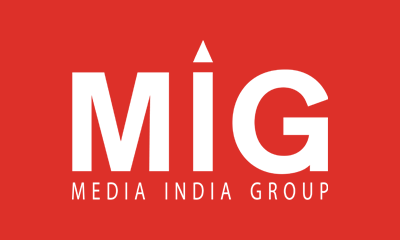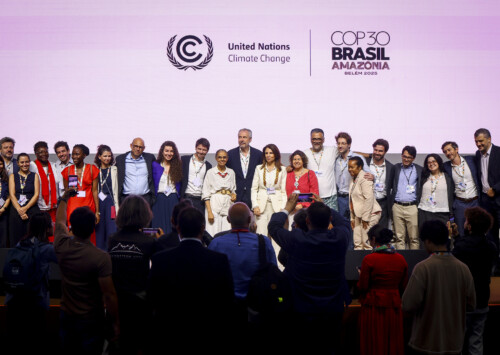Indian television news media sinks to new lows
Outright lies rule the waves
Ever since the arrival of Narendra Modi as Prime Minister of the country, the television media has completely abdicated its basic responsibility of holding the government to account and switched to targetting the opposition for every failure of the government and prioritising sensationalism over objective reporting. But in the recent conflict between India and Pakistan, the media sank even lower, moving from mere sensationalism to outright lies.
“Indian Navy Destroys Karachi Port”
“Islamabad Captured, (Pakistan Prime Minister) Shehbaz Sharif Surrenders”
“Pak Military Coup, Pak Army Chief Detained”
These dramatic words may read like scenes from a war movie, but in fact that they were headlines broadcast live on major Indian news channels during the recent conflict between India and Pakistan, when almost entire country was watching the news carefully and with concern over the latest developments as the two neighbours got into yet another violent conflict, misleading hundreds of millions of viewers.
On May 9, Aaj Tak, one of India’s top Hindi news channels, aired a breaking news segment titled: “पाकिस्तान पर भारत का चौतरफा हमला, Lahore-Karachi में भारी नुक़सान” (“India’s All-Out Attack on Pakistan, Heavy Losses in Lahore-Karachi”). During the show, anchor Anjana Om Kashyap claimed that the visuals shown were of a Pakistani drone attack being intercepted in Jaisalmer. The same footage was later aired by anchor Shweta Singh, presented again as proof of India’s military success.
In a more serious turn, multiple news channels including Zee News, Aaj Tak, and News Nation reported that the Indian Navy had destroyed Karachi Port, showing dramatic visuals of a huge explosion. However, independent and international media quickly debunked these claims, revealing that the footage was old and unrelated to any current event.
A day earlier, ABP News aired a bulletin titled “India-Pakistan War Update: Blackouts in Srinagar and Ludhiana”, again creating panic all over northern India as citizens worried about their safety.
These broadcasts followed a series of tragic events in India, including a terrorist attack in Pahalgam, Kashmir, which killed 26 tourists. In the weeks that followed, the country also faced a deadly plane crash and rising military tensions with Pakistan. During such difficult times, the public looked to the media for calm, accurate reporting. Instead, many television news channels failed to meet that responsibility, often spreading misinformation and fuelling fear.
In several instances, television news fell behind even unverified social media posts and fake YouTube channels in peddling false information. Rather than verifying facts, some chose to sensationalise and most resorted to bare lies to gain more eyeballs.
For more than a decade, notably since Narendra Modi took charge as the Prime Minster of the country, Indian television media has been facing criticism for biased and dramatic reporting. These recent failures have only deepened the public’s mistrust. Reflecting this decline, India now ranks 151 out of 180 countries in the 2024 World Press Freedom Index by Reporters Without Borders.
When newsrooms chose lies over truth
During the conflict with Pakistan, sparked by India’s military response to the deadly terrorist attack in Pahalgam, Kashmir, the two countries exchanged heavy shelling, used drones and deployed advanced military equipment along the border.
At a time when the nation needed calm, factual and responsible reporting, most Indian television news channels chose a different path. Instead of focussing on verified updates, several channels used dramatic visual effects (VFX) to sensationalise the conflict, turning serious reporting into a theatrical show.
“Media sensationalised both tragedies, ethical lines blurred, with privacy and accuracy sometimes sacrificed for breaking news. Sensationalism heavily drives Indian news coverage today, often prioritising drama and emotion over factual news,” a television reporter based in Delhi, who wished to remain anonymous tells Media India Group.
But the problem did not stop there. Alongside the exaggerated visuals, fake news was broadcast without proper fact-checking. One of the most notable examples was the widespread reporting that the Indian aircraft carrier INS Vikrant had destroyed Karachi Port in a powerful attack. News channels showed videos and images claiming to prove the strike.
However, these claims were entirely false. The footage was either unrelated or digitally altered, and it was later confirmed that INS Vikrant had not taken part in any such operation during the entire conflict. But by the time the truth emerged, the lies had already spread across television and social media, further adding to confusion and misinformation.
“Our relatives and family members live in border areas, and because of network issues and blackouts we could not connect with them. When we turned to TV channels to get an update on the situation, all we saw was fake news and disinformation,” Rajni Sharma, based in Delhi tells Media India Group.
“Pahalgam tragedy was made a mockery of by TV news channels, truly it was shameful the reportage that reduced the sheer magnitude of the incident. Newspaper reportage was better. However, once Operation Sindoor happened, media across board reported it as some major PR exercise,” Nitya, a student, tells Media India Group.
This conflict with Pakistan may shown the media sink to new lows, but it was not an isolated incident showcasing the unethical approach of the television media in the country, which has consistently cast aside truth in favour of higher television ratings or TRPs.
Another recent example of sensationalised and irresponsible media coverage was the crash of Air India flight AI-171, on June 12, which resulted in the deaths of around 270 people. Instead of focussing on facts or providing helpful updates, some news outlets rushed to publish unverified claims and emotional headlines that added to public fear and confusion.
For instance, shortly after the crash, a few tabloids speculated that the pilot had ignored warnings, even though no official investigation had even begun at the time.
“I have been told some channels like India Today did cross ethical lines on the crash site, stepped onto debris which was key in the forensic investigation. Times Of India, a leading daily, did go wrong with its information on the pilot’s last words too,” adds the television reporter based in Delhi.
These recent events, and many more, have shown how parts of the Indian television media continue to struggle with responsible reporting. Instead of offering clear, fact-checked information, many chose speed and drama, often at the cost of accuracy and ethics. In a country where millions rely on the news to stay informed, this approach not only misleads the public but also damages the credibility of journalism itself.
“Most of the time newsrooms are all about the competitor breaking something, showing some visuals a few minutes before you. That has often times led to unverified or dated visuals going on air, TRP pressures are real and definitely takes precedence over journalistic integrity at times,” a journalist with NDTV, who wished to remain anonymous tells Media India Group.










